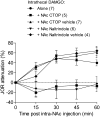Nucleus accumbens facilitates nociception
- PMID: 21458450
- PMCID: PMC3100434
- DOI: 10.1016/j.expneurol.2011.03.021
Nucleus accumbens facilitates nociception
Abstract
We have previously demonstrated an opioid link in nucleus accumbens (NAc) that mediates antinociception produced by a novel ascending pain modulation pathway. For example, noxious stimulation induces heterosegmental antinociception that is mediated by both mu- and delta-opioid receptors in NAc. However, spinal intrathecal administration of the mu-receptor agonist [D-Ala(2), N-Me-Phe(4),Gly(5)-ol]-enkephalin (DAMGO) also induces heterosegmental antinociception. The aim of the present study in the rat was to identify the intra-NAc opioid receptors that mediate the antinociceptive effects of spinally administered DAMGO and also to determine the effect of NAc efferent activity on nociception. Intra-NAc administration of either the mu-opioid receptor antagonist Cys(2),Tyr(3), Orn(5),Pen(7)amide (CTOP) or the delta-opioid receptor antagonist naltrindole blocked the antinociceptive effect of spinally administered DAMGO on the jaw-opening reflex (JOR). Injection of quaternary lidocaine (QX-314) attenuated the JOR, suggesting that the output of NAc is pronociceptive. In support of this, intra-NAc injection of the excitatory amino acid agonist kainate enhanced the JOR. Thus, it is possible to modulate activity in NAc to bidirectionally attenuate or enhance nociception, suggesting a potential role for NAc in setting nociceptive sensitivity.
Copyright © 2011 Elsevier Inc. All rights reserved.
Figures





Comment in
-
Two negatives make a positive: telencephalic-mediated analgesia.Exp Neurol. 2012 Aug;236(2):336-8. doi: 10.1016/j.expneurol.2012.04.026. Epub 2012 May 8. Exp Neurol. 2012. PMID: 22580343 No abstract available.
Similar articles
-
mu/delta Cooperativity and opposing kappa-opioid effects in nucleus accumbens-mediated antinociception in the rat.Eur J Neurosci. 2002 Mar;15(5):861-8. doi: 10.1046/j.1460-9568.2002.01915.x. Eur J Neurosci. 2002. PMID: 11906528
-
Interactions among mu- and delta-opioid receptors, especially putative delta1- and delta2-opioid receptors, promote dopamine release in the nucleus accumbens.Neuroscience. 2005;135(1):213-25. doi: 10.1016/j.neuroscience.2005.03.065. Neuroscience. 2005. PMID: 16111831
-
Contribution of spinal inhibitory receptors in heterosegmental antinociception induced by noxious stimulation.Eur J Neurosci. 2003 Dec;18(11):2999-3006. doi: 10.1111/j.1460-9568.2003.03031.x. Eur J Neurosci. 2003. PMID: 14656295
-
The spinal antinociceptive effects of endomorphins in rats: behavioral and G protein functional studies.Anesth Analg. 2008 Jun;106(6):1873-81. doi: 10.1213/ane.0b013e31817300be. Anesth Analg. 2008. PMID: 18499626 Free PMC article.
-
Role of opioid receptors in the spinal antinociceptive effects of neuropeptide FF analogues.Br J Pharmacol. 1996 Feb;117(3):493-501. doi: 10.1111/j.1476-5381.1996.tb15217.x. Br J Pharmacol. 1996. PMID: 8821539 Free PMC article.
Cited by
-
Ventral tegmental area dopaminergic circuits participates in stress-induced chronic postsurgical pain in male mice.BMC Neurosci. 2024 Jan 9;25(1):3. doi: 10.1186/s12868-023-00842-z. BMC Neurosci. 2024. PMID: 38195391 Free PMC article.
-
Chronic pain: the role of learning and brain plasticity.Restor Neurol Neurosci. 2014;32(1):129-39. doi: 10.3233/RNN-139003. Restor Neurol Neurosci. 2014. PMID: 23603439 Free PMC article. Review.
-
Pain Catastrophizing Is Associated With Increased Alcohol Cue-Elicited Neural Activity Among Individuals With Alcohol Use Disorder.Alcohol Alcohol. 2022 Nov 11;57(6):727-733. doi: 10.1093/alcalc/agac029. Alcohol Alcohol. 2022. PMID: 35788255 Free PMC article. Clinical Trial.
-
Brain-derived neurotrophic factor-mediated projection-specific regulation of depressive-like and nociceptive behaviors in the mesolimbic reward circuitry.Pain. 2018 Jan;159(1):175. doi: 10.1097/j.pain.0000000000001083. Pain. 2018. PMID: 29076919 Free PMC article.
-
SIRT1 Mediates Neuropathic Pain Induced by Sciatic Nerve Chronic Constrictive Injury in the VTA-NAc Pathway.Pain Res Manag. 2020 Aug 18;2020:4245968. doi: 10.1155/2020/4245968. eCollection 2020. Pain Res Manag. 2020. PMID: 32922581 Free PMC article.
References
-
- Ahn DK, Kim YS, Park JS. Central NO is involved in the antinociceptive action of intracisternal antidepressants in freely moving rats. Neurosci Lett. 1998;243:105–108. - PubMed
-
- Banks D, Kuriakose M, Matthews B. Modulation by peripheral conditioning stimuli of the responses of trigeminal brain stem neurones and of the jaw opening reflex to tooth pulp stimulation in chronically prepared, anaesthetized cats. Exp Physiol. 1992;77:343–349. - PubMed
-
- Belforte JE, Barceló AC, Pazo JH. Striatal modulation of the jaw opening reflex. Brain Res. 2001;891:138–147. - PubMed
-
- Buelke-Sam J, Holson JF, Bazare JJ, Young JF. Comparative stability of physiological parameters during sustained anesthesia in rats. Lab Anim Sci. 1978;28:157–162. - PubMed
-
- Chiang CY, Dostrovsky JO, Sessle BJ. Role of anterior pretectal nucleus in somatosensory cortical descending modulation of jaw-opening reflex in rats. Brain Res. 1990;515:219–226. - PubMed
Publication types
MeSH terms
Substances
Grants and funding
LinkOut - more resources
Full Text Sources
Medical
Research Materials

